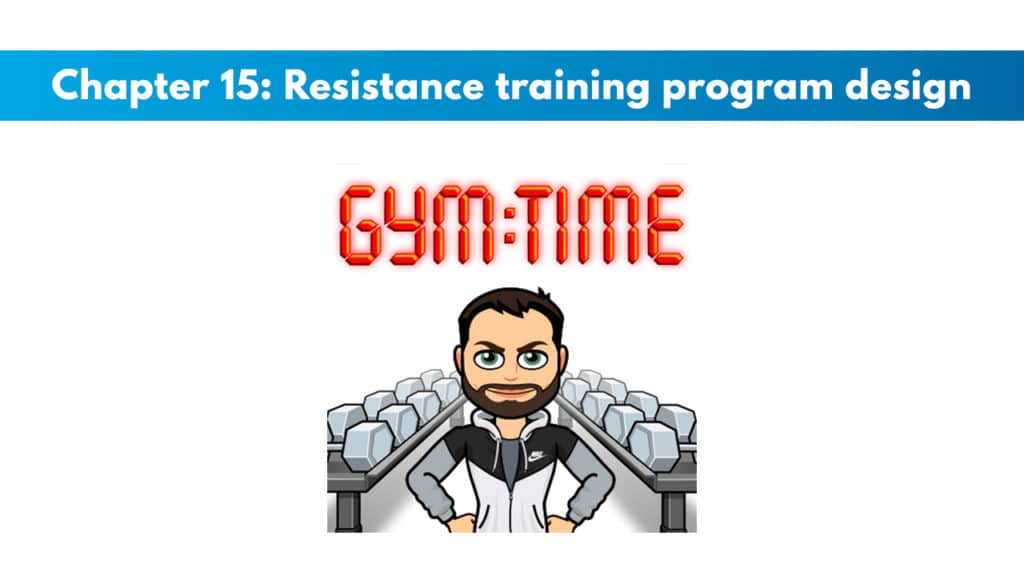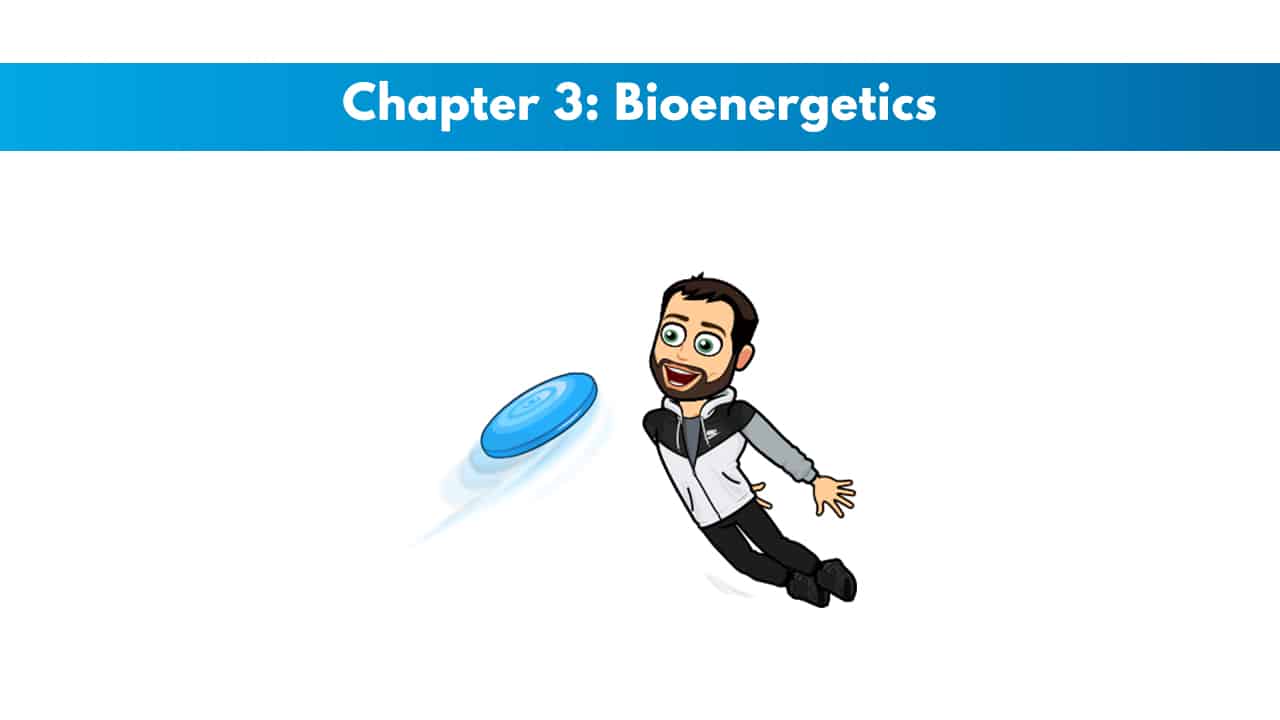
Get your copy of the NSCA CPT exam cheat sheet. It helps immensely for studying for the exam.
Make sure to check out Trainer Academy for premium NSCA CPT study materials. They will reduce study time by 50% and have an exam pass guarantee. Read my full review on them here. You can save $100 on their MVP study system with the code: PTPSUB
Chapter Objectives:
- Know how to apply specificity, overload, progression, and sequencing.
- Be able to select exercises, decide on training frequency, and arrange the sequences of exercises.
- Find the proper loading using 1 rep max, body weight, and rep max testing.
- Give loads, volumes, and rest periods, using the client’s needs and appropriate sequential training methods.
- Put variation in training sessions, days, and weeks.
- Know when loads should be changed.
General Training Principles
Any program not addressing all of these problems can fail in meeting the client’s goals, have bad adherence to programs, and have possible litigation due to risk injury increases.
Specificity
This is at the foundation of every training program. When speaking about specificity in training, as we use it, we define it as a specific way of training someone to produce some targeted change.
If someone specifically wants to strengthen their legs and lower body, the trainer will implement moves that focus on these parts. We also call this muscle group specificity.
We implement this into programs by looking at what someone desires to train. If they enjoy some sport, such as volleyball, you would see that jumping is a major aspect, and thus o train with this principle, their program would implement moves specifically for the desired increases in jump strength. With volleyball and jumping, we would most likely look at the Olympic lift.
Overload
This is the training stress or intensity being greater than the usual loads of the client. There will be limited results if there is no overload in the programs.
To use overload, we increase the weight being used in exercises.
Variation
This is the manipulation of very specific variables like rest interval, intensity, frequency, exercise selection, and movement speed.
Periodization is the best way to apply training variation. This is the use of logical phases and the manipulation of training factors within them.
We may have periods of strength focus followed by periods of power focus, and that is the use of periodization.
Progression
Training stress and intensity are altered to continue making positive adaptations.
Changing the stress as someone is adapting is known as progressive overload. This allows someone to become better trained.
Initial Fitness Consultation and Evaluation
This initial meeting is used to see the compatibility of the trainer and client, establish an agreement, talk about goals, and determine commitment levels.
Initial Resistance Training Status and Experience
The first step is to answer five basic questions.
- Are you currently participating in a resistance training program?
- For how long have you followed a resistance training program?
- How many times per week do you train?
- How intense are your workouts?
- What types of exercises are performed in your workouts, and how many are done with proper technique?
The combination of these questions will be used to determine the training status of the client from beginner to advanced.
Fitness Evaluation
This is an essential assessment of the heart rate, blood pressure, weight, height, body comp, girth, flexibility, endurance, and body strength.
This is used to determine where the client is and find the strengths and weaknesses to work on.
Primary Resistance Training Goal
This is imperative for the specificity portion of a client’s program.
Muscular Endurance
This type of training is used to enhance the ability of muscles to perform at Submax levels for many reps over a greater time.
Hypertrophy
This is about an increase in muscle size. It is training that leads specifically to an increase in fat free mass and reductions in body fat.
Muscular Strength
This type of training is for someone wanting to increase their ability to carry heavier loads.
It could be for daily activities or strictly for gym activities.
Muscular Power
This type of training is only used for athletes looking to improve their performance in their sport of choice.
Determination of Training Frequency
Frequency is the number of workouts someone will do within one week.
Exclusive PTP CPT Offers |
||
|---|---|---|
Gold Standard Cert | Most Popular Cert | Best Study Materials |
A Good Option | A Good Option | Best CPT for you?  |
Influential Factors
Trainers need to look at the training status of a client and the overall level of fitness that they have.
Training may need to decrease for some clients in times of a lot of stress in their life.
Guidelines for Determining Training Frequency
Recovery is an important thing to consider when looking at the training frequency.
Typically, we follow the rule that you should wait at least one day (but not any more than 3 days) before working out the same muscle group.
The level of response to resistance workouts depends highly on the client and their experience level.
Novice or Beginner Resistance Training Status
- The recommendation is 2 – 3 sessions per week.
Intermediate Resistance Training Status
- The recommendation is 3 when doing full body routines and 4 when doing a split routine.
Advanced Resistance Training Status
- The recommendation is 4 – 6 workout sessions per week.
A split routine is typically something like 3 days on and one day off. We target specific muscle groups that are different in the three days that are on, and then the fourth day is for rest.
Exercise Selection
The specificity, equipment, client experience, and training time can influence this.
Influential Factors
The clients’ needs and the goals discussed in the initial consultation are of the utmost importance.
Types of Resistance Training Exercises
Core Exercises
These should make up the bulk of the program because of their effectiveness in helping achieve specific goals.
Core exercises are called such when they:
- Involve two or more main joints; thus, it is a multijoint exercise.
- Engage larger muscles while activating the synergists, too.
When a core exercise loads the axial skeleton, it will also be classified as a structural exercise. These exercises require the torso muscles to work to keep the body upright. This could be an exercise like a squat.
Assistance Exercises
These supplementary exercises are done to keep muscular balance in a joint, prevent injury, rehabilitate some old injuries, or isolate specific muscles.
An exercise is called an assistance exercise if it:
- It is a single joint, meaning it only uses one main joint.
- Recruits small amounts of muscle mass.
A basic exercise example would be the bicep curl with a barbell.
Guidelines for Choosing Exercises
For novice and beginning clients, trainers need to look at having more of a training base building focus. Typically, this is with the use of assistance exercises and basic core exercises. A basic philosophy is choosing one exercise for each of the body’s major muscle groups to focus on for each workout.
When training an athlete, it is important to have exercises to train relevant movement patterns for their sport.
When working with clients with special needs, like injuries to the back or other recent pains, you should adapt the program to suit them.
Exercise Order
This is basically defined as the arrangement of the exercises to be done within an exercise session.
Influential Factors
The influencing factors for exercise order are things like the client’s goals, the potential of fatigue from the exercise, and the type of exercise.
Guidelines for Arranging Exercises
Placing Power and Core Exercises Before Assistance Exercise
One way would be to have power exercises at the start, then core exercises, followed by resistance exercises.
Another form is your multijoint exercises followed by the single joint exercises.
The third way is with large muscle exercises followed by small muscle exercises.
These are more or less just ways to describe the same thing: start with your bigger, more complicated movements, and end with the least complicated and more focused ones.
The theory behind them is that the power moves will require the most effort, and to do them the best, and you must have energy.
Alternating Push and Pull Exercises
This has one day with all of your pushing exercises followed by another day of your pulling exercises.
This allows you to rest the muscles from the day before, as you don’t use the same muscles pushing as you do with pulling.
Exclusive PTP CPT Offers |
||
|---|---|---|
Gold Standard Cert | Most Popular Cert | Best Study Materials |
A Good Option | A Good Option | Best CPT for you?  |
Alternating Upper and Lower Body Exercises
This exercise type is like the push and pull, but now it is the upper body one day and the lower body the next. You will again be resting on the one you didn’t work on the previous day.
Combination Arrangement Methods
This is using two or three of the previous methods. So, you’d focus on one, rest, and then do another one.
Secondary Arrangement Methods
This involves completing a set of two different exercises with intervening rest times. If you are training the same muscle group with two exercises coupled together, it is known as a compound set. A superset is called if it uses two opposing muscle groups in succession.
Training Load: Resistance and Repetitions
The training LOAD is the amount of weight that will be used in a program and is possibly the most important part of the program in terms of design. The training program and its desired goals determine the load and reps.
Influential Factors
Percentage of 1 rep max relationship
Repetition maximum is the max load the client can take in a certain exercise for a set number of reps. For example, it would be the absolute max weight someone can bench press 5 times. That would be your 5 rep max.
One rep max is the typically used term and factor when dealing with assigning load. This is the most weight you do for only one rep.
Loads are often assigned based on a percentage of someone’s one rep max. This would be a rep max, depending on the desired reps.
We can also assign a range that is called the rep max range.
Limitations in the percent 1 rep max relationship
1. The %RM and number of reps may be related somewhat, but not as robustly as once thought.
2. Trained status affects the rep numbers at given percentages, with the more trained people being able to do more.
3. When doing multiple sets, the fatigue may add up; thus, the percent max may not be the same.
4. Percent rep research focuses on the bench press, squat, and power clean.
5. Resistance training mode affects the max.
6. More reps can be done at percent rep maxes for core exercises.
7. Exercise order affects the rep maxes.
Guidelines for Assessing Load Capabilities
Methods for assessing load capabilities:
Directly testing 1RM.
Estimating the 1RM.
Using percent of body weight for testing.
Repetition max testing.
Assessing the 1 rep max
This is the gold standard for the assessment of muscular strength.
The biggest issue to worry about is the technique of the client. If that is good, the test should be reliable and accurate.
We assess the 1RM directly by warming up and working up to the 1RM slowly. Then the weight at which only one rep can be performed and no more is the one rep max.
Estimating the 1 rep max
We can use a rep max test or use a prediction equation.
The rep max test is like the 1RM test, but we aim to do a set number of reps instead. Or we have a weight, do the most reps, and then base that off the standard percentages.
The chart in the book provides the percentages and rep maxes.
Percent of Body Weight Testing
This is for untrained and inexperienced clients, as there is a big correlation between 1RM and weight for them, but not for the well-trained clients.
A trial load is determined based on their weight.
Repetition max testing
This is where we choose a goal rep for a set and reach that with the weight and no more.
The higher the reps, the more likely fatigue will increase and be less accurate.
Guidelines for Assigning Load
Depending on the training goal for all of these load assignments, the reps will change, but the percentages are consistent with the reps.
For example, someone going through a hypertrophy training phase would shoot for 6 – 12 reps and the percentages would be between 67 and 85%.
Training Volumes: Repetitions and Sets
Volume load is equal to the total reps multiplied by the load used.
Volume is a big indicator of the level of work done in resistance training.
Guidelines for Assigning Volume
Resistance Training Goals
Muscular Endurance: This is typically seen as more repetitions, in the realm of more than 10 per set, with sets varying depending on training status.
Hypertrophy: the plan focuses on a higher training volume of 6 – 12 reps, with moderate to high loads of 67 – 85%.
Muscular Strength: For core exercises, we see plans of 6 or fewer reps with sets of three or more per exercise. Assistance exercises use 8 or more reps with 1 – 3 sets.
Power Exercises: These shouldn’t be done with untrained and new clients. Strength should be focused on first. Here we see 3 sets of 3 – 6 reps for intermediate people and 3 – 6 sets of 1 – 6 reps for the more advanced clients.
Resistance Training Status
Starting out, we can see the need for only single set programs, but we eventually have to progress to multiple sets in our training. We also become more proficient with our movements and may progress to one rep max testing or power exercise training over time.
Rest Intervals
This is the time interval between multiple sets of work.
The amount of time is predicted by the goals of the client.
Influential Factors
The heavier the load taken on, the more rest will be needed for recovery.
Training status should also be considered, as beginners may need a little more time.
Guideline for Establishing Rest Intervals
Resistance Training Status
There is much more rest for beginners until their bodies can adjust to the workloads of resistance training. 2 – 5 minutes is the typical rest interval used for these clients.
Resistance Training Goal
Muscular Endurance: These have relatively short rest intervals of about 30 seconds between the sets during circuit training and 3 minutes of rest between exercises of similar muscle groups.
Muscular Hypertrophy: Rest intervals here are short to even moderate. They range from 30 seconds to about 1 and a half minutes.
Muscular Power: These have typical rest times of 2 – 5 minutes between the max effort sets.
Muscular Strength: The general time is 2 – 5 minutes here, too.
Variation
This is simply the alteration of training variables to produce adaptations over time.
Within Session Variation
Varying the intensity throughout the session, the rest intervals, and changing the training stimulus are common ways to vary our workouts.
Within Week Variation
Varying the intensities throughout the sessions in the week along with load are the most popular ways.
Between Week Variation
Here we can vary the volume, intensity, frequency, exercises, and training focus to bring variation.
Progression
This is the process of clients going toward their goal that was determined beforehand. This can be seen through increases in load, volume, or frequency. The load and volume is the most common way to progress. Periodic rep max tests are used to assess the need for progressing the program and varying loads and volumes.
The 2 for 2 rule says that if a client can do two or more reps than the goal in an exercise on two consecutive training sessions, they should then increase the load.
If you want assistance wrapping your head around this material, make sure to check out Trainer Academy for some awesome NSCA study materials. They have Practice tests, flashcards, and a fantastic study guide. They even offer an exam pass guarantee.

 Have a question?
Have a question? 



![NSCA CPT vs CSCS - Which Certification Is Best in [year]? 9 NSCA CPT vs CSCS](https://www.ptpioneer.com/wp-content/uploads/2020/03/NSCA-CPT-vs-CSCS.jpg)
![Free NSCA CPT practice test + study guide/flashcards [year] 10 FREE NSCA Study Guide](https://www.ptpioneer.com/wp-content/uploads/2019/09/FREE-NSCA-Study-Guide.jpg)





Tyler Read
PTPioneer Editorial Integrity
All content published on PTPioneer is checked and reviewed extensively by our staff of experienced personal trainers, nutrition coaches, and other Fitness Experts. This is to make sure that the content you are reading is fact-checked for accuracy, contains up-to-date information, and is relevant. We only add trustworthy citations that you can find at the bottom of each article. You can read more about our editorial integrity here.